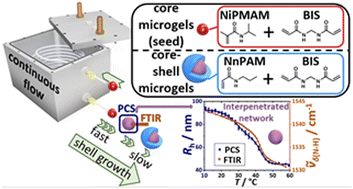Core–shell microgels synthesized in continuous flow: deep insight into shell growth using temperature-dependent FTIR†
Abstract
While core–shell microgels have been intensively studied in their fully synthesized state, the formation mechanism of the shell has not been completely understood. Such insight is decisive for a customization of microgel properties for applications. In this work, microgels based on a N-isopropylmethacrylamide (NiPMAM) core and a N-n-propylacrylamide (NnPAM) shell are synthesized in a continuous flow reactor. The shell growth is studied depending on the solution's time of residence inside the reactor. PCS experiments reveal a significant decrease of the volume phase transition temperatures of the core and the shell, with increasing residence time. At early stages, a decreased swelling capacity is found before a discrete NnPAM shell is formed. Temperature-dependent FTIR spectroscopy shows that the decreased swelling capacity originates from a pronounced interpenetrated network (IPN) between NnPAM and NiPMAM. AFM images resolve heterogeneously distributed shell material after 3 min, pointing to an aggregation of NnPAM domains before the distinct shell forms. The combination of diffusional properties, AFM images and vibrational information confirms a deeply interpenetrated network already at early stages of the precipitation polymerization, in which the shell material heavily influences the swelling properties.



 Please wait while we load your content...
Please wait while we load your content...